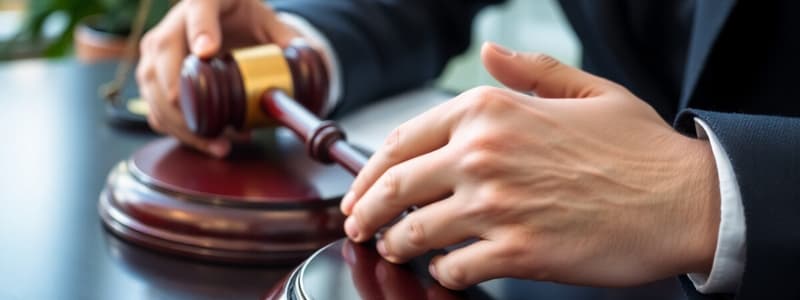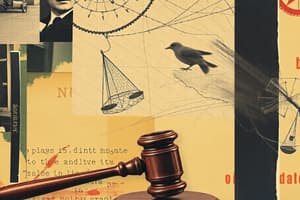Podcast
Questions and Answers
What is the primary focus of personal injury and property damage law?
What is the primary focus of personal injury and property damage law?
- Criminal law violations
- Claims made in accident scenarios (correct)
- Insurance policy disputes
- Family law issues
Which of the following is NOT one of the elements that must be proved in a claim under the law of torts?
Which of the following is NOT one of the elements that must be proved in a claim under the law of torts?
- Establishing duty
- Proving damages
- Proving breach of duty
- Demonstrating intent to harm (correct)
In what circumstance would contract law be relevant in personal injury and property damage cases?
In what circumstance would contract law be relevant in personal injury and property damage cases?
- When negotiating settlements with insurance companies
- When filing a lawsuit for emotional distress
- When dealing with governmental liability claims
- When advising a client regarding vehicle repairs (correct)
Which legal principle is fundamental for succeeding in personal injury claims?
Which legal principle is fundamental for succeeding in personal injury claims?
Which aspect of civil rights is particularly relevant in the context of PIPD?
Which aspect of civil rights is particularly relevant in the context of PIPD?
What can the negligence of a defendant potentially lead to in PIPD cases?
What can the negligence of a defendant potentially lead to in PIPD cases?
Which of the following refers to a claim where the claimant must prove how the defendant's actions led to their losses?
Which of the following refers to a claim where the claimant must prove how the defendant's actions led to their losses?
What is one of the first areas of law a practitioner should become familiar with for PIPD work?
What is one of the first areas of law a practitioner should become familiar with for PIPD work?
What does the term 'contract of good faith' refer to in insurance law?
What does the term 'contract of good faith' refer to in insurance law?
Which of the following areas is NOT explicitly mentioned as a primary focus in PIPD work?
Which of the following areas is NOT explicitly mentioned as a primary focus in PIPD work?
Which publication is referenced as a significant resource for practitioners in PIPD work?
Which publication is referenced as a significant resource for practitioners in PIPD work?
What is a key feature of the Moto Accident Guide?
What is a key feature of the Moto Accident Guide?
Which of the following best describes the relationship between law of tort, law of contract, and insurance law in the context of PIPD work?
Which of the following best describes the relationship between law of tort, law of contract, and insurance law in the context of PIPD work?
In what scenario might you advise an insurance company according to the content provided?
In what scenario might you advise an insurance company according to the content provided?
What is the primary purpose of having basic insurance coverage for vehicles in Singapore?
What is the primary purpose of having basic insurance coverage for vehicles in Singapore?
Which best describes the importance of understanding the three areas of law in PIPD work?
Which best describes the importance of understanding the three areas of law in PIPD work?
What type of accidents does the Moto Accident Guide specifically address?
What type of accidents does the Moto Accident Guide specifically address?
What is the primary purpose of the guidelines mentioned in the text?
What is the primary purpose of the guidelines mentioned in the text?
Which publication is referred to as the 'blue book'?
Which publication is referred to as the 'blue book'?
How are the guidelines for assessing general damages organized?
How are the guidelines for assessing general damages organized?
What edition of the Guidelines for the Assessment of General Damages is mentioned?
What edition of the Guidelines for the Assessment of General Damages is mentioned?
In legal practice, who is likely to use the guidelines for personal injury damages?
In legal practice, who is likely to use the guidelines for personal injury damages?
What aspect of personal injury cases do the guidelines help quantify?
What aspect of personal injury cases do the guidelines help quantify?
Why might practitioners request a digital or hard copy of the guidelines?
Why might practitioners request a digital or hard copy of the guidelines?
What is emphasized about the guidelines' role in court submissions?
What is emphasized about the guidelines' role in court submissions?
What group of professionals primarily refers to the 'Guidelines for the Assessment of General Damages'?
What group of professionals primarily refers to the 'Guidelines for the Assessment of General Damages'?
What primary distinction is made between the guidelines and the blue book?
What primary distinction is made between the guidelines and the blue book?
What is the primary function of the Motor Claims Framework (MCF)?
What is the primary function of the Motor Claims Framework (MCF)?
When dealing with a chain collision, what aspect does the Barometers of Liability Agreement (BOLA) specifically address?
When dealing with a chain collision, what aspect does the Barometers of Liability Agreement (BOLA) specifically address?
Which of the following is NOT a typical reason for insurers to repudiate insurance coverage?
Which of the following is NOT a typical reason for insurers to repudiate insurance coverage?
What should a client do after an accident to comply with necessary reporting procedures?
What should a client do after an accident to comply with necessary reporting procedures?
What options are available to a client when acting as a claimant?
What options are available to a client when acting as a claimant?
What is the primary use of the Practitioner Library?
What is the primary use of the Practitioner Library?
What type of information does the table with explanatory notes provide?
What type of information does the table with explanatory notes provide?
Which group contributed to the creation of the table with explanatory notes?
Which group contributed to the creation of the table with explanatory notes?
Why is the U curve in the multipliers table significant?
Why is the U curve in the multipliers table significant?
What is a unique feature of the table regarding future losses?
What is a unique feature of the table regarding future losses?
What does the MAKO application simulate?
What does the MAKO application simulate?
What overarching benefit does the new multipliers table provide for PIPD practitioners?
What overarching benefit does the new multipliers table provide for PIPD practitioners?
What type of guidance does the Practitioner Library provide to lawyers?
What type of guidance does the Practitioner Library provide to lawyers?
Who typically uses the resources provided in the Practitioner Library?
Who typically uses the resources provided in the Practitioner Library?
What is the primary audience for the table with explanatory notes?
What is the primary audience for the table with explanatory notes?
Flashcards
Personal Injury and Property Damage (PIPD)
Personal Injury and Property Damage (PIPD)
Claims related to injuries and damages in accident scenarios, often involving road traffic accidents.
Law of Torts
Law of Torts
The part of law governing wrongdoing causing harm to other people or their property.
Elements of Tort Claim
Elements of Tort Claim
Four elements needed to successfully sue someone for wrongdoing: duty, breach of duty, causation of harm, and damages.
Duty
Duty
Signup and view all the flashcards
Breach of Duty
Breach of Duty
Signup and view all the flashcards
Causation
Causation
Signup and view all the flashcards
Damages
Damages
Signup and view all the flashcards
Contract Law
Contract Law
Signup and view all the flashcards
PIPD Work
PIPD Work
Signup and view all the flashcards
Insurance Law (Singapore)
Insurance Law (Singapore)
Signup and view all the flashcards
Contract of Good Faith
Contract of Good Faith
Signup and view all the flashcards
Motor Accident Guide
Motor Accident Guide
Signup and view all the flashcards
Liability Apportionment
Liability Apportionment
Signup and view all the flashcards
Accident Scenarios (Guide)
Accident Scenarios (Guide)
Signup and view all the flashcards
Policyholder Rights
Policyholder Rights
Signup and view all the flashcards
Insurance Company Rights
Insurance Company Rights
Signup and view all the flashcards
What is the MCF?
What is the MCF?
Signup and view all the flashcards
What is a BOLA?
What is a BOLA?
Signup and view all the flashcards
Who does BOLA NOT apply to?
Who does BOLA NOT apply to?
Signup and view all the flashcards
Reporting Centre or Authorized Workshop
Reporting Centre or Authorized Workshop
Signup and view all the flashcards
Repudiation of Insurance Cover
Repudiation of Insurance Cover
Signup and view all the flashcards
Legal Precedents
Legal Precedents
Signup and view all the flashcards
Guidelines for General Damages
Guidelines for General Damages
Signup and view all the flashcards
Quantum
Quantum
Signup and view all the flashcards
Body Parts & Injuries
Body Parts & Injuries
Signup and view all the flashcards
Practitioner's Library
Practitioner's Library
Signup and view all the flashcards
Opinion for Clients
Opinion for Clients
Signup and view all the flashcards
Submission to Courts
Submission to Courts
Signup and view all the flashcards
High Court Reference
High Court Reference
Signup and view all the flashcards
Familiarization
Familiarization
Signup and view all the flashcards
PIPD Quantum
PIPD Quantum
Signup and view all the flashcards
Table with Explanatory Notes
Table with Explanatory Notes
Signup and view all the flashcards
U Curve
U Curve
Signup and view all the flashcards
Mortality Rate
Mortality Rate
Signup and view all the flashcards
MAKO
MAKO
Signup and view all the flashcards
Liability
Liability
Signup and view all the flashcards
Multiplier
Multiplier
Signup and view all the flashcards
Future Losses
Future Losses
Signup and view all the flashcards
Claim Value
Claim Value
Signup and view all the flashcards
Study Notes
Personal Injury and Property Damage (PIPD)
- PIPD claims arise from accidents involving injury or property damage.
- Accidents are common and cause infringement of civil rights.
- Key area of law: laws of tort, contract, and insurance
- Law of tort: proving duty, breach of duty, causation, and damages
- Client-vehicle repair: addresses contractual relationships.
- Hospitals and clients: contracts of service
- Insurance law: contract of good faith; policyholders' rights.
- Insurance companies rights, vis-a-vis policyholders and other parties.
Legal References for PIPD
- Moto Accident Guide: A guide with accident scenarios (e.g., junctions, car parks, cyclists).
- Guidelines for the Assessment of General Damages: Provides quantum for damages; categorized by body part.
- Practitioner's Library Assessment of Damages: Textbook covering damages, cases, and summary (blue book).
- Table with explanatory notes: Committee based (judges, lawyers, MAS members), provides multipliers for losses (e.g., future earnings, medical expenses).
- MAKO (Moto Accident Claims Online): Online simulation program to estimate liability and value.
Lecture 1: Immediate Steps
- Stop the vehicle immediately.
- Call police and/or ambulance (if needed).
- Exchange details.
- Take photographs.
- Avoid admitting fault or liability.
- Call a tow truck (if needed).
- Seek advice from insurer hotline (if necessary).
Motor Claims Framework (MCF)
- Agreement between defendant and insurance companies to expedite payment.
- One insurer covers the others.
Barometers of Liability (BOLA)
- Applies in chain collisions, affecting subsequent vehicles (2nd and beyond).
- Direct liability to subsequent vehicles.
- BOLA does not apply to the claimant.
Studying That Suits You
Use AI to generate personalized quizzes and flashcards to suit your learning preferences.
Related Documents
Description
This quiz delves into the principles of Personal Injury and Property Damage (PIPD) claims, examining the laws of tort, contract, and insurance. Explore the rights of policyholders and insurance companies while understanding key legal documents and assessment guidelines related to accidents. Test your knowledge on the intricacies of establishing duty, breaches, and damages in civil law.


